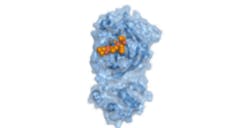Coronavirus therapies developing slowly due to intermittent outbreaks
Purdue University scientists Andrew Mesecar, Walther Professor in Cancer Structural Biology and head of the Department of Biochemistry, and Arun Ghosh, the Ian P. Rothwell Distinguished Professor of Chemistry, have been working to develop both oral medicines and vaccines to fight coronavirus, and over the next two weeks, will be working to test their potential drug molecules on the new SARS-like Wuhan coronavirus. However, any drug that is identified to work on the Wuhan coronavirus will not be available quickly enough to help patients in the current outbreak. But the researchers hope that they can use the discoveries they make with the current virus to better mitigate future outbreaks.
The molecules Mesecar and Ghosh have developed block two of the coronavirus enzymes (proteases), stopping coronavirus from replicating.
"The drug targets we've identified are over 95% identical to the enzyme targets we saw on the SARS virus," Mesecar says. "In 2002 when the SARS outbreak happened, it took months to get to the point where we are now," he says. "With this outbreak, scientists were able to isolate the virus and sequence the genome in less than two weeks. One week later, an additional 20 genomes were available. In another week or two, we'll be able to begin to see if the virus is mutating."
In identifying drug targets on the coronavirus, they take an anti-viral approach similar to what Ghosh used to develop the anti-HIV drug Darunavir, which is sold under the brand name Prezista.
The conornavirus is a common virus in animals and humans that can cause respiratory symptoms of the common cold and flu — only occasionally are there outbreaks of a more serious, flu-like illness. Beginning in 2002, a coronavirus outbreak caused by the SARS variant of the virus killed more than 750 people worldwide. From 2012 to 2015, the MERS coronavirus, which is more distantly related to SARS than the Wuhan virus, killed nearly 450 people, according to the World Health Organization. Coronavirus infections can be more serious in cats and piglets; in both cases it is nearly 100% fatal.
The Wuhan coronavirus resembles a Sputnik-era satellite covered in antennas, which the scientists refer to as spike proteins. These spikes are thought to look like the rays of the sun or a corona, which is how the coronavirus got its name.
"MERS virus and the SARS virus are more different genetically," Mesecar says. "But the Wuhan virus is genetically almost identical to the SARS virus and, therefore, it is expected to look and act nearly the same.
The intermittent nature of the outbreaks and the relatively small market for the drug —thousands of patients in an outbreak, instead of millions of patients for some chronic diseases —means that pharmaceutical companies have little incentive to develop the drugs for humans.
Late on Jan. 17, 2020, Mesecar and colleagues at the Center for Structural Genomics of Infectious Disease received the genome of the Wuhan coronavirus, and he and his team analyzed the genome on Saturday. Mesecar found the genome is almost identical to that of the SARS virus.
"This week we are analyzing the genomes from viruses taken from 20 individual patients, and we'll be looking at those sequences to see if there is any variation in the genetics," he said.
Mesecar collaborates on the virus research with a team of scientists across the U.S. who make up the Center for Structural Genomics of Infectious Diseases, which is based at Northwestern University's Feinberg School of Medicine. The center is funded by the National Institutes of Health's National Institute of Allergies and Infectious Diseases.
But Mesecar is working to set up a rapid-response system of scientists that could quickly develop drugs during future outbreaks caused by genetic variants of the coronavirus. The goal is to have a library of U.S. Food and Drug Administration (FDA)-approved or almost approved compounds that have been predetermined to work on specific coronaviruses so that when an outbreak appears, medicines can be produced and distributed quickly.
"We will be able to do this within my lifetime," he says.
